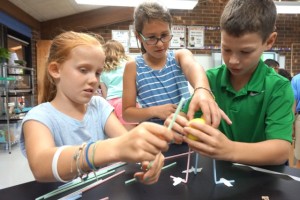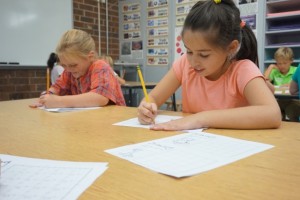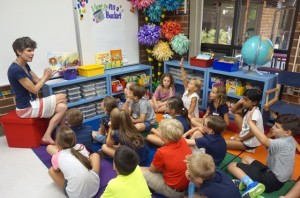By Smarty Guest Blogger, Mary Yorke Oates, Director of Admissions, Charlotte Latin School
The first day of school is filled with excitement. In so many ways, everything is like a brand new pack of crayons. The tips are sharp, the colors are organized, and the options are endless. The lunch boxes are clean, and the paper is crisp. For Kindergartners, we have packed so much hype into the start of school. From the grocery store to the mall, there are aisles and aisles of items to buy for school with an underlying message that we better get it now, lest there is a totally unexpected shortage of 3 by 5 index cards. After all, it might be impossible to go into a retail space once school starts. And even if we don’t need anything, we are still tempted to think, “Maybe we do need something. Will Sally be behind if I don’t get this?”
So, what do we really need to do to prepare our youngest for school? And more importantly, what do we parents need to do to prepare ourselves for the start of school?
Every Kindergarten teacher will say one word with conviction. Routine. Give them a routine especially around meals, bedtimes and cleaning up. Child psychologist and trusted guru of development, Louise Ames of the Gesell Institute, devotes a chapter to routines in her book Your Five-Year-Old. As a young mom I failed to remember one thing when my oldest first went off to school. My Kindergarten student—the center of my world and the most independent of my three babies—was going to be one of many. He was entering a community where routine would be all important. Even though I didn’t mind cutting the crust for one, peeling the orange for another, and leaving off the jelly for the third, I didn’t have 22 children to navigate. I also didn’t have to teach my three children how to read, write, get along with 21 new people, become a math thinker, transition to Art and Playground, and move safely as a group. I did have to referee and multi-task daily but with hindsight, my most important job was to love them, care for them, and teach them to be kind and generous. My husband, the psychologist, used to say the healthiest children all experienced a little benign neglect. In other words, his message to me was that on most days, beyond being a responsible, loving parent, I should let it roll. The Legos need not be organized by color coding, the socks did not have to match, and the four-year old did not need computer lessons. But he, too, was a stickler for routine especially around meals and sleep time.
Ames states, “Fives really like to do what is expected of them, at the table as well as everywhere else” (19). This is a simple statement, yet a powerful concept. Fives look to please us, and why not provide successful chances to empower them? If we ask them to tackle reading when their eyes cannot even track from left to right, they know immediately they have disappointed us because their brains can’t accommodate our non-developmental approach. But ask them to work on chewing first and talking second or teach them to spread jelly on toast, and you might see incredible confidence emerge. Establish a bed and bath routine, and they will follow. They are eager to learn things they can master. And, what I know now is that they learn just like they are: in kid time which requires us to slow down and let patterns unfold. I tended to teach in my time, rapidly with analytical attention to detail because that worked for me everywhere else.
I was always too quick to spread the jelly. I hated sticky fingers, countertops, and any sort of chaos in general. It never occurred to me that if I let them work on such a simple, albeit messy task, they would master it. What I failed to realize was that I was more interested in my efficiency. Who wants to add a task to the already mundane meal time? I had to bite my lip to read the “long” book he picked out at bedtime, even though the routine meant he could pick out the book. But, if I had just deleted the stuff that didn’t matter—the color coded lego bin, for example—I might not have been so impatient with the messy, and at times, extremely boring-to-me stuff.
When the school year ends, that crayon box will probably be long gone and will be replaced with a Ziploc bag. Most of the crayons will be little stubs and some will be taped together where they snapped in two. The crisp paper will be covered in colors, letters, numbers, and pencil smudges. The teachers will have taken all that bright shiny hope that walked in the door in late August, and they will have transformed it. If you are like me, you too, will be transformed. According to the experts, the best news of all is this: if we just make home a predictable place with simple routines, they can soak up more than we realize. To see all a child can do, when he or she is inspired to learn like a five-year old, is staggering. Messy, for sure. But through that wonderful commitment to routine and development, the research proves itself and the results are often magical.
Ames, Lousie and Frances Ilg. Your Five-Year- Old: Sunny and Serene. Dell, 1979.
![]()
Charlotte Latin School
9502 Providence Road
Charlotte, NC 28277a
704-846-1100
Admissions Office: 704-846-7207
website: www.charlottelatin.org
facebook: www.facebook.com/charlottelatinschool
twitter: @charlottelatin



